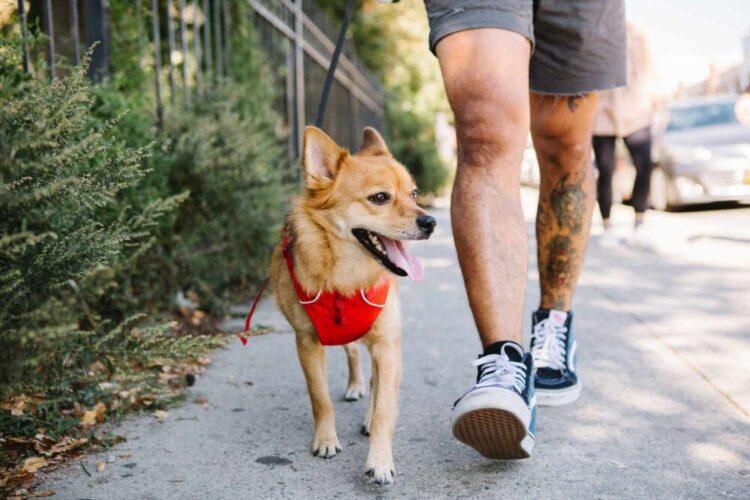Business
How To Ease Your Dog’s Anxiety Naturally: A Guide To Canine Calmness

Just like humans, our canine buddies can also experience anxiety for various reasons. Recognizing and addressing your furry friend’s anxiety is crucial for their overall well-being. In this guide, we’ll explore what anxiety is, how it manifests in dogs, and several natural approaches to help your canine companion find calmness. Here are some triggers for anxiety and ways to help your dog overcome them.
Table of Contents
Common Triggers For Canine Anxiety
- Separation: Dogs are social animals, and being left alone for extended periods can trigger separation anxiety.
- Loud Noises: Fireworks, thunderstorms, or even construction sounds can be distressing for dogs with noise sensitivity.
- Changes in Environment: Moving to a new home, changes in the household, or unfamiliar surroundings can cause stress. Even changes with their food or belongings can trigger anxiety. For example, if your buddy hasn’t had chews for a long time, consider getting them calming chews for dogs to avoid anxiety from building up.
How Anxiety In Dogs Differs From Humans
While anxiety shares similarities across species, there are key differences between how it manifests in dogs compared to humans.
Communication Challenges
People can easily articulate their feelings and verbalize their anxieties, while dogs solely rely on body language and vocalizations. Understanding your dog’s cues, such as tail position, ear movement, and vocalizations, is essential for recognizing their anxiety.
Source Of Anxiety
While humans often experience anxiety related to work, relationships, or future uncertainties, dogs primarily face anxiety triggered by environmental factors or changes in routine. Identifying and addressing these specific triggers is crucial in managing canine anxiety.
Response To Stressors
Dogs may exhibit anxiety through behaviors like pacing, whining, or destructive chewing. Understanding these signals can help pet owners intervene early and provide support.
Natural Approaches To Ease Canine Anxiety
- Create A Safe Haven
Dogs appreciate having a secure and comfortable space where they can retreat when feeling anxious. Designate a quiet corner with their bed, toys, and a blanket. This provides them with a familiar and reassuring environment, helping to reduce stress.
- Establish A Consistent Routine
Dogs thrive on routine, and sudden changes can trigger anxiety. An effective way to drive away stress is to have a consistent daily schedule for your dog’s activities. Predictability provides a sense of security, helping your dog feel more at ease in their daily life.
- Physical Exercise For Mental Well-being
Regular exercise is not only essential for your dog’s physical health but also plays a crucial role in mental stimulation. Engaging in activities like walks, fetch, or interactive play helps release excess energy, reducing anxiety levels.
- Natural Supplements
Certain supplements can have a calming effect on dogs. For example, chamomile and valerian roots are known for their relaxing properties. Consult with your veterinarian before introducing any supplements to your dog’s diet to ensure they are safe and appropriate for your pet.
- Calming Aromatherapy
Aromatherapy can be beneficial for dogs, just as it is for humans. Lavender and chamomile scents have calming effects. Consider using dog-friendly essential oil diffusers or placing scented sachets in their sleeping area to create a soothing atmosphere.
- Gentle Massage And Touch
Physical touch is a powerful tool in reducing anxiety. Gentle massages or cuddling with your dog can release oxytocin, a hormone that promotes bonding and relaxation. Pay attention to your dog’s body language to ensure they are comfortable with the level of touch.
- Positive Reinforcement Training
Training sessions based on positive reinforcement can boost your dog’s confidence and reduce anxiety. Rewarding desired behaviors with treats or praise creates a positive association, helping your dog feel more secure in different situations.
Conclusion
While the methods mentioned above can be effective, it’s crucial to be patient and consistent in your efforts. It would also help if you acknowledge that your dog’s condition might be due to anxiety and not just any simple condition. If anxiety persists or worsens, consult with a veterinarian for personalized advice and potential additional interventions. By taking a holistic and natural approach, you can help your beloved canine companion lead a happier and more relaxed life.

-

 Business3 years ago
Business3 years agoHow to Do Long-Distance Moves with Children
-

 Travel2 years ago
Travel2 years agoQuick Guide: Moving To Santa Rosa?
-

 Real Estate3 years ago
Real Estate3 years agoWhy Dubai Festival City is a Great Neighbourhood for Young Learners
-

 Business3 years ago
Business3 years agoIs Guest Posting a Good Inbound Marketing Strategy?
-

 Business1 year ago
Business1 year agoThe Ultimate Guide To Thriving In Your Printing Franchise
-

 Business1 year ago
Business1 year agoExploring The Benefits And Challenges Of Restaurant Franchising
-

 Tech3 years ago
Tech3 years agoCyber Table That Will Change Your Life
-

 Lifestyle1 year ago
Lifestyle1 year agoDallas’ Hidden Gems: 6 Must-Try Restaurants Off The Beaten Path!









Recent Comments